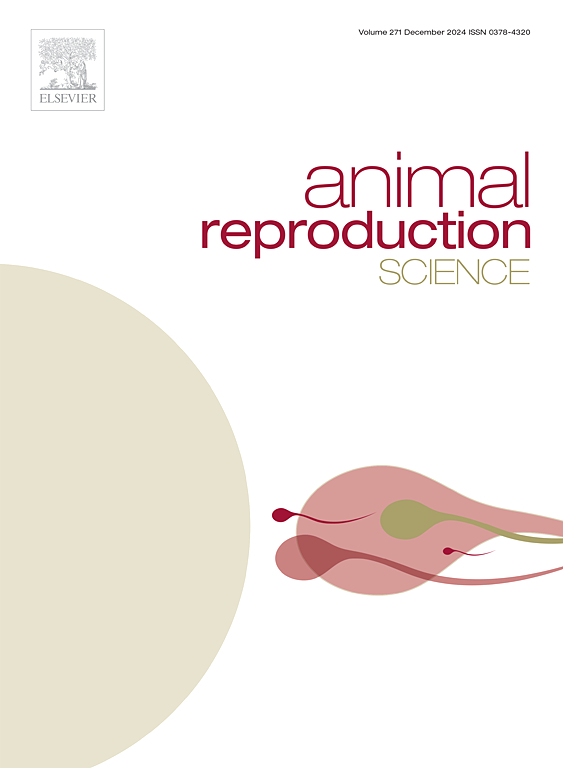Epithelial-mesenchymal transition during the growth and involution of the prostate gland in wild ground squirrels (Spermophilus dauricus)
IF 3.3
2区 农林科学
Q1 AGRICULTURE, DAIRY & ANIMAL SCIENCE
引用次数: 0
Abstract
The prostate glands of wild ground squirrels display enlarged volume during the breeding season and shrunk size during the nonbreeding season, which enables the wild ground squirrel to be an ideal animal model for studying the mechanisms of prostate growth and involution. To clarify the possible mechanism underlying seasonal morphological changes of the prostate in wild ground squirrels, epithelial-mesenchymal transitions (EMT) were focused, and the expression of EMT-related genes was investigated in the current study. Histological results showed that the epithelial lumen enlarged in the breeding season, and the stromal cells expanded during the non-breeding season. Transcriptomic analysis showed 132 EMT-related genes expressed differentially in the prostate during breeding versus non-breeding seasons, indicating EMT might occur during the morphological changes of the prostate. To further confirm the EMT process, the immunolocalizations of EMT markers were inspected, which showed the positive staining of E-cadherin, Claudin-1, ZO1, β-catenin, N-cadherin, VIMENTIN, SLUG, and ZEB1 were presented in epithelial and/or stromal cells. The expressions of Cdh1, Cldn, Tjp1, Ctnnb1, and Snai2 increased in the prostate of the breeding season, while the expressions of Cdh2, Vim , and Zeb1 reduced in the prostate of the breeding season. Moreover, the expression levels of the epithelial marker Cdh1 and the mesenchymal markers Cdh2 and Vim were found to be positively or negatively correlated with prostate weight, respectively. In conclusion, the current results suggested that the EMT might be responsible for prostate growth and involution in the wild ground squirrel.
野生地松鼠(Spermophilus dauricus)前列腺生长和内缩过程中的上皮-间质转化
野生地松鼠的前列腺在繁殖季节体积增大,在非繁殖季节体积缩小,因此野生地松鼠是研究前列腺生长和内缩机制的理想动物模型。为了阐明野生地松鼠前列腺季节性形态变化的可能机制,本研究重点研究了上皮-间质转化(EMT),并调查了EMT相关基因的表达。组织学结果显示,上皮腔在繁殖季节扩大,而基质细胞在非繁殖季节扩大。转录组分析表明,在繁殖期和非繁殖期,前列腺中有132个EMT相关基因表达不同,这表明EMT可能发生在前列腺的形态变化过程中。为了进一步证实EMT过程,研究人员对EMT标记物进行了免疫定位,结果显示E-cadherin、Claudin-1、ZO1、β-catenin、N-cadherin、VIMENTIN、SLUG和ZEB1在上皮细胞和/或基质细胞中呈现阳性染色。繁殖期前列腺中 Cdh1、Cldn、Tjp1、Ctnnb1 和 Snai2 的表达量增加,而繁殖期前列腺中 Cdh2、Vim 和 Zeb1 的表达量减少。此外,还发现上皮标记物 Cdh1 以及间质标记物 Cdh2 和 Vim 的表达水平分别与前列腺重量呈正相关或负相关。总之,目前的研究结果表明,EMT可能是野生地松鼠前列腺生长和内陷的原因。
本文章由计算机程序翻译,如有差异,请以英文原文为准。
求助全文
约1分钟内获得全文
求助全文
来源期刊

Animal Reproduction Science
农林科学-奶制品与动物科学
CiteScore
4.50
自引率
9.10%
发文量
136
审稿时长
54 days
期刊介绍:
Animal Reproduction Science publishes results from studies relating to reproduction and fertility in animals. This includes both fundamental research and applied studies, including management practices that increase our understanding of the biology and manipulation of reproduction. Manuscripts should go into depth in the mechanisms involved in the research reported, rather than a give a mere description of findings. The focus is on animals that are useful to humans including food- and fibre-producing; companion/recreational; captive; and endangered species including zoo animals, but excluding laboratory animals unless the results of the study provide new information that impacts the basic understanding of the biology or manipulation of reproduction.
The journal''s scope includes the study of reproductive physiology and endocrinology, reproductive cycles, natural and artificial control of reproduction, preservation and use of gametes and embryos, pregnancy and parturition, infertility and sterility, diagnostic and therapeutic techniques.
The Editorial Board of Animal Reproduction Science has decided not to publish papers in which there is an exclusive examination of the in vitro development of oocytes and embryos; however, there will be consideration of papers that include in vitro studies where the source of the oocytes and/or development of the embryos beyond the blastocyst stage is part of the experimental design.
 求助内容:
求助内容: 应助结果提醒方式:
应助结果提醒方式:


